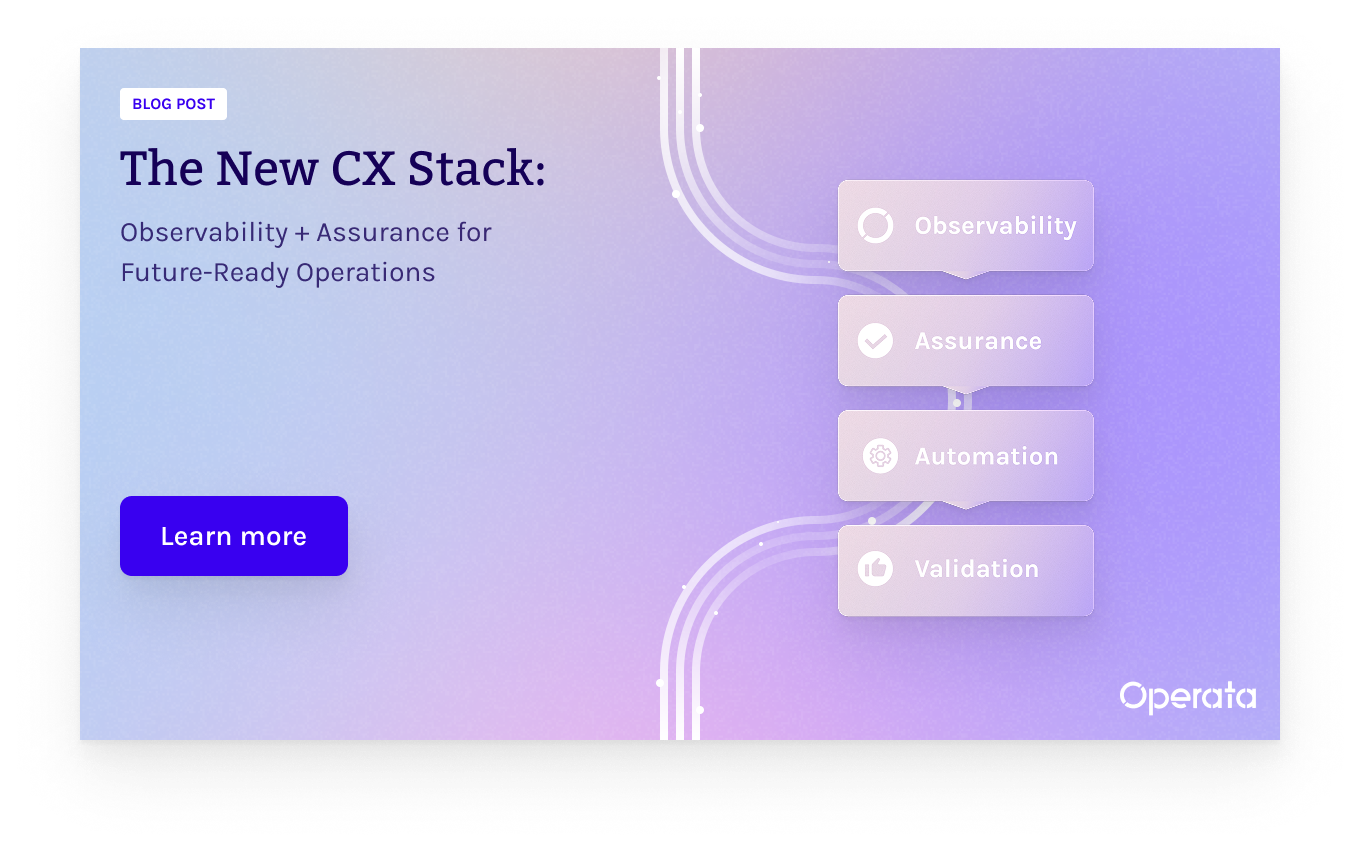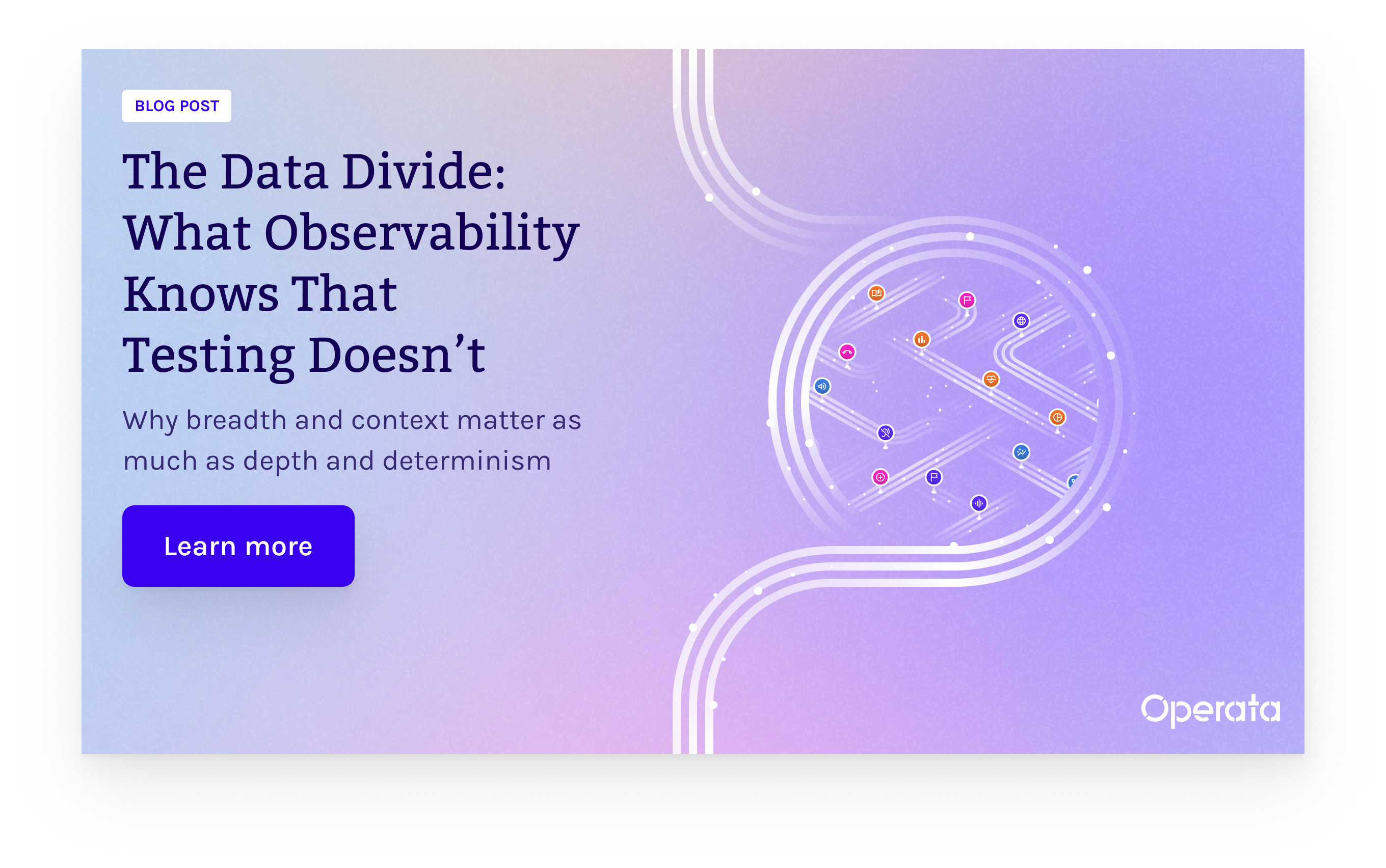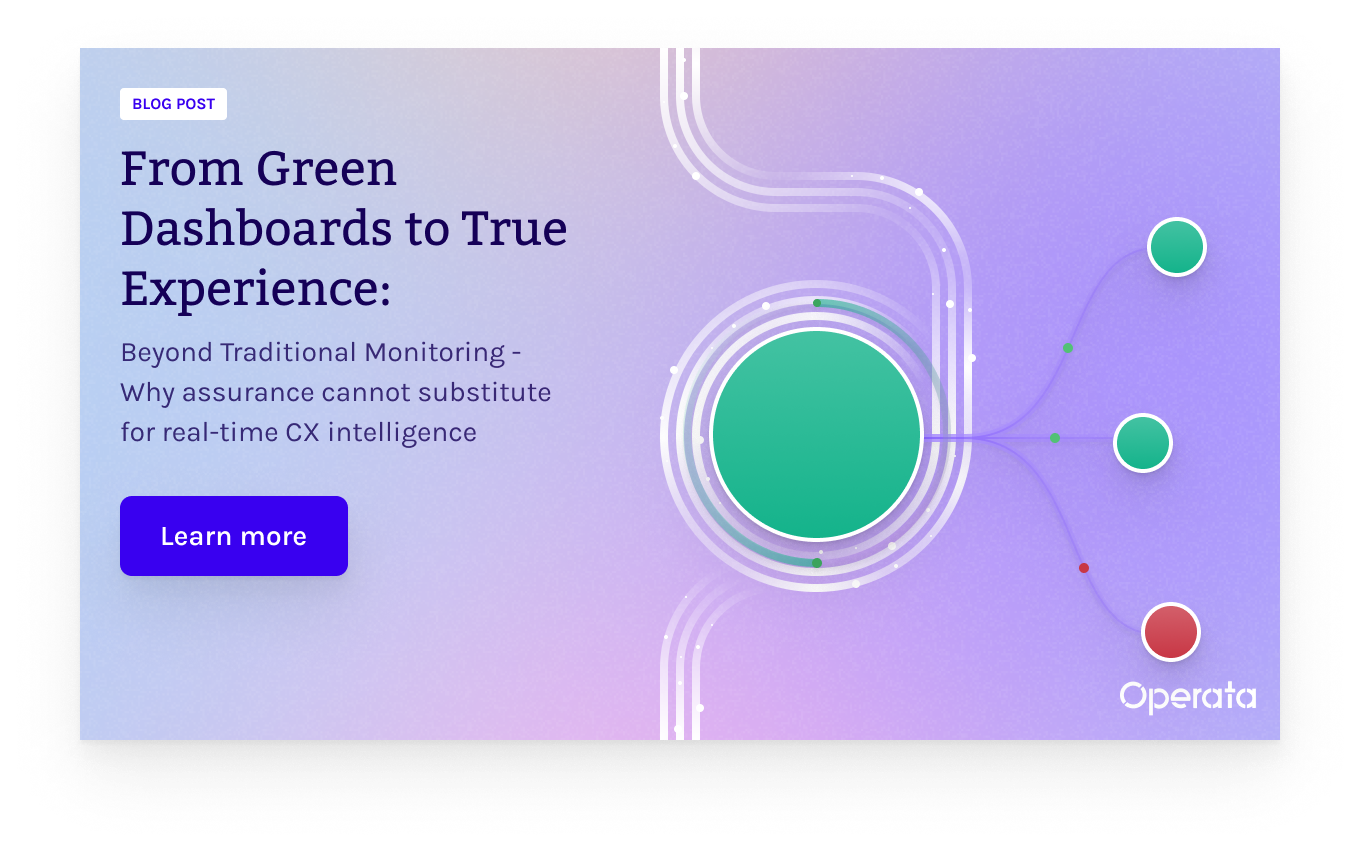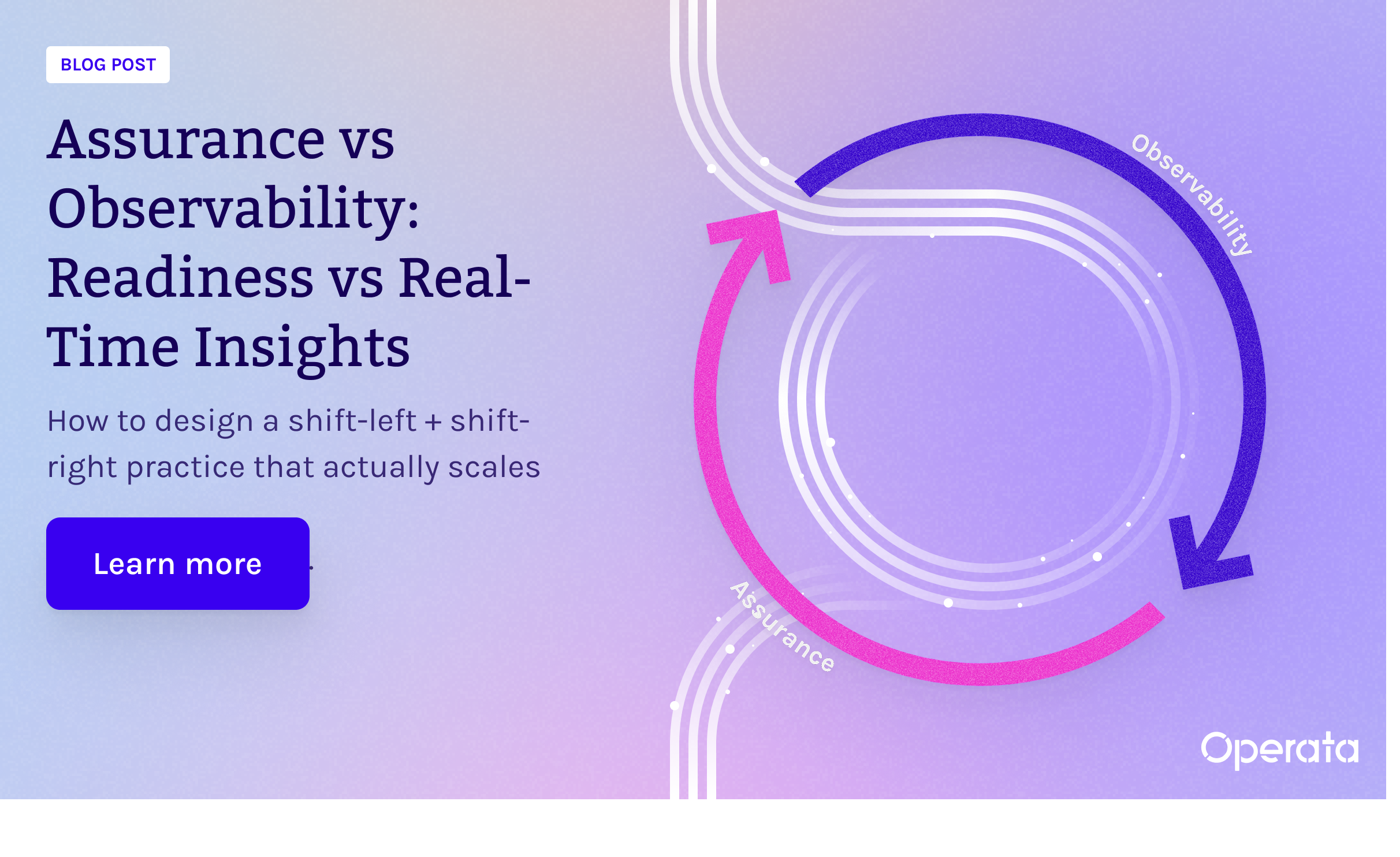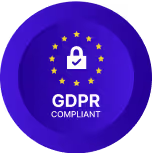You’ve decided to move your contact center to the cloud. Smart choice. As the foundation for contact center transformation, CCaaS solutions position you to be more agile, more responsive to customers and changing business conditions, and more efficient, all with greater performance and scale.
However, whether you’ve already migrated to the cloud or are currently putting together your plans, you need to account for CX Observability as an essential source of insights for your entire contact center organization. It will help you anticipate, identify, and resolve issues, perform end-to-end testing, justify investments to enhance customer experience, improve your KPIs, and accelerate your CCaaS time-to-value.
What is CX Observability?
CX Observability is the practice of gaining real-time insights into customer and agent experience through the continuous monitoring and analysis of technical, operations, and experience data from systems supporting the contact center. Moreover, by analyzing those four data domains within a unified CX Observability platform, unique insights can be obtained through correlation across domains.
For example, a majority of contact centers now employ at-home agents, and face challenges when monitoring voice quality and agent performance. Using Operata, contact centers can understand differences in performance between agents in the office versus at home, and more importantly, uncover technical issues that may be contributing to those differences.
How Does CX Observability Differ from Other Observability Tooling?
CX Observability stands as a distinct evolution of general purpose observability tooling, uniquely tailored to illuminate contact center agent and customer experience. Additionally, CX Observability uncovers the correlated nuances of customer interactions and sentiment within CCaaS environments, unlike conventional observability tools focused on technical metrics and system performance.
By harnessing advanced analytics, AI-driven insights, and real-time user journey mapping, CX Observability empowers contact centers to not only anticipate, identify, and troubleshoot technical issues but also to understand the holistic user journey, optimize touchpoints, and enhance overall satisfaction. In essence, CX Observability bridges the gap between technical data and human-centric insights, enabling organizations to cultivate customer relationships that are not just rooted in robust performance, but also in deeply gratifying experiences.
What are the Benefits of CX Observability?
CX Observability introduces a new way for businesses to understand and optimize customer experiences, and delivers a number of benefits:
- Increased customer satisfaction
- Improve customer experience with fewer issues and faster handling times, leading to higher CSAT and loyalty.
- Accelerated CCaaS time-to-value
- Gain data and insights to quickly move to a CCaaS platform with confidence.
- Higher agent productivity
- Lower Average Handling Times (AHT), suffer less downtime, and employ happier agents.
- Lower mean time to resolve (MTTR)
- Correlate data sources to gain insights, identify issues, determine root causes, and resolve them quickly.
- Improved AI effectiveness
- Deliver the audio quality required to get the most from AI-powered transcription, sentiment analysis, virtual agents, and more.
- Control of service quality across all your contact centers
- Measure performance and SLAs independently for CCaaS, agent, BPO, MSP, partners, internal teams, applications, and carriers you rely on.
- Lower costs
- Reduce call times, focus investment in the right areas, optimize spend, and measure what matters.
- Greater compliance visibility
- Monitor agent compliance with company policies or regulatory requirements through experience data like conversational analytics
Moreover, CX Observability fosters collaboration between your agents, technical teams, and business teams, breaking down silos and ensuring a customer-centric approach across the organization. Ultimately, it drives customer loyalty and advocacy, propelling business growth and revenue.
What are Typical Business Outcomes Delivered by CX Observability?
CX Observability delivers significant business outcomes through unprecedented insights and end-to-end optimizations across the customer journey. Valuable benefits ranging across technical, operations, and experience aspects of the business include:
- 60% reduction in IT support costs
- Faster MTTD & MTTR and more uptime from end-to-end diagnostics and insights to quickly focus on problem areas.
- 90% reduction in agent disruption cost
- Proactive agent self-fix with less time reporting issues and responding to IT information requests.
- 3.4% increase in agent productivity
- Agents free up valuable time previously lost in IT issues and troubleshooting.
Why Don’t CCaaS Solutions Provide CX Observability?
The simple answer is: they can’t. CCaaS vendors prefer to maintain a clear SLA, security, and compliance “demarcation line” between their cloud infrastructure and yours. While very little PII data is accessible by a CX Observability solution and presents only a minor concern for security and compliance, there are a number of other legitimate reasons for CCaaS vendors to avoid providing CX Observability themselves:
- They likely can't fix issues found in your environment because they don't have full access or control.
- If vendors provide CX Observability data, they are then in part responsible for the performance and resolving issues surfaced by the data. I.e., it draws them into helping/assisting with issues residing outside of their demarcation.
- There’s a slight conflict of interest for the vendor to proactively identify issues with their service.
Even when using a cloud-based solution, you have a technical environment that is within your scope of control: the network (which must be optimized for voice traffic), agent workstations (which need to efficiently process media and data), and headsets (which place demands on other technology in your environment).
Additionally, CCaaS vendors don’t have complete real-time visibility into all four data domains described earlier: technical, operations, and experience data. Without full visibility, and deep domain expertise across contact center, network, telco, architecture, software, etc., correlation across data domains is challenging or impossible. Here are some of the key customer and agent experience insights you can only access with Operata CX Observability:
- Which agents with high dropped call percentages also have persistent internet connection issues?
- Which agents with longer handle times also have persistent voice quality issues?
- What are the drivers behind an agent’s low customer sentiment scores - high background noise, poor voice quality, heavy use of hold, talking over the customer, etc.?
- Do longer IVR times correlate with lower customer sentiment?
- How do longer queue times impact AHT and customer sentiment?
- Does agent behavior regarding number of missed calls, use of hold, etc change when working from home vs. the office?
- How much of an impact does poor voice quality have on customer sentiment?
- Are 3rd-party agents providing a lower level of service?
- Are agents happier working from home?
- Are customers happier when dealing with agents working from home?
- Is a degradation of AX (and CX) across the day reduced by a higher quality headset?
When Should an Enterprise Deploy CX Observability?
In moving to Amazon Connect, Trustpower needed visibility on quality and performance. In hindsight, we should have put Operata in sooner.
— Rachel Southon, Delivery & Technology, Trustpower
Operata Platform is “Day 1” technology, meaning it is ideally deployed as a contact center migrates to the cloud. While some may argue that it can wait until the migration is complete, we have heard statements from enough customers like Trustpower that we’re convinced it provides value starting from day 1.
Operata is Day 1 technology because: 1) it protects and optimizes your CCaaS investment, 2) it mitigates risk during migration, and 3) it accelerates CCaaS time-to-value. Reason #3 is particularly important, because accelerated time-to-value ensures that additional investments in improving customer experience can be justified and funded appropriately.
Ultimately, observability tools are invaluable at detecting change, resolving issues and proving success. Never is this more important than in migration. By definition, there is more change, there will be more issues, and the faster you can deal with the problems and resulting FUD (Fear, Uncertainty, and Doubt), then the faster you will move and the more successful your migration will be.
Many organizations making the move to a CCaaS solution will employ traditional testing and assurance tools to help measure the initial quality of service and identify major issues.
The tools of the past, especially testing tools, were invaluable when you had end-to-end control of your environment. In the cloud, this isn't the case. While it's important to ensure your configuration is correct, you don't need to send a text to Amazon Web Services for scalability, you don't need to test if Genesys can handle a call at any time of the day, you don’t need to verify if NICE can route a call to the correct agent.
You need to understand your environment, the drivers within that environment, and understand changes within that environment. Sometimes changes will be across your entire contact center, sometimes regionally, and sometimes focused on individual agents.
The only way to manage change effectively when you don't have control over the entire environment is to monitor end-to-end observability data in real time and over longer-term patterns and trends, with proactive insights and recommendations that are optimized for CCaaS deployments.
Essential Insights for Your Entire Organization
As a complement to a CCaaS solution, CX Observability is an essential source of insights for your entire organization. It helps you anticipate, identify, and fix issues, perform end-to-end testing, justify CX investments, improve KPI results, and accelerate CCaaS time-to-value.
Ultimately, CX Observability doesn't just optimize technical aspects of your contact center; through its human-centric approach it transforms your organization into a customer-focused powerhouse, capable of achieving sustained success in a competitive landscape.
To learn more about how CX Observability can help your organization, read our whitepaper on the Total Economic Benefit of Operata. Or, if you’d like to explore the Operata Platform further, sign up for a free trial.




